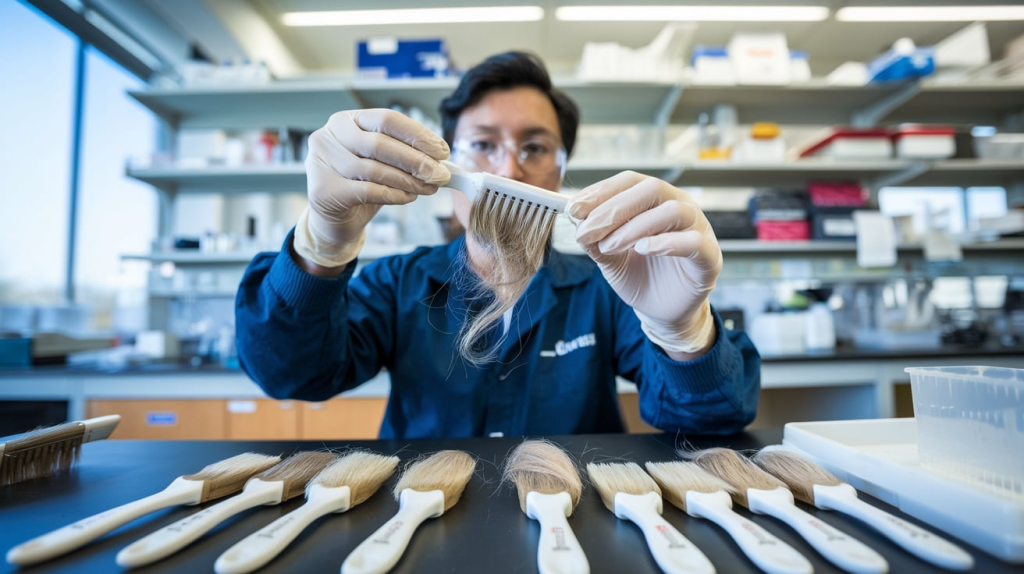Collecting hair samples for research has become increasingly popular across a range of studies, from forensic science to genetic and medical research. A practical and non-invasive method for obtaining hair is by collecting it from brushes or combs. If you are conducting a study involving hair samples, understanding the IRB (Institutional Review Board) guidelines is crucial to ensure ethical compliance. This article will delve into the essentials of collecting hair samples from brushes and the associated IRB guidelines.
Why Collecting Hair Samples From Brushes Research IRB Guidelines ?
Collecting hair samples from brushes research irb guidelines provides numerous benefits. It is a non-invasive, cost-effective, and convenient method for both researchers and participants. Hair contains valuable biological information that can reveal insights into genetics, hormone levels, drug exposure, and even diet, making it a crucial resource in many research studies.
Hair is a valuable resource in scientific research, providing critical insights into genetics, drug exposure, hormone levels, and even diet. By collecting hair samples from participants’ personal brushes, researchers can minimize the discomfort and intrusiveness of traditional sampling methods. This approach is simple, cost-effective, and convenient for both participants and researchers, making it an attractive option for many studies.
However, with this convenience comes responsibility, particularly in regard to maintaining ethical standards. Here is where the IRB guidelines come into play.
IRB Guidelines for Collecting Hair Samples from Brushes
1. Informed Consent for Collecting Hair Samples from Brushes
To simplify complex information for participants, consider providing examples or analogies. For instance, instead of using scientific jargon, you could say: “We will use a small amount of hair from your brush to study general health markers, much like how a doctor might use a blood test to check your health.” This helps participants easily understand what will happen and reduces confusion.
Informed consent is a key element when collecting hair samples. According to IRB guidelines, researchers must inform participants about what the study entails, including the collection of hair samples. Participants must understand how their hair will be used, the potential risks, and their rights to withdraw at any point.
Informed consent must be clear, without scientific jargon that could confuse participants. Specifically, when collecting hair from brushes, researchers need to clarify if there is any intention to test for sensitive information like drug use, DNA analysis, or other private biological markers.
2. Privacy and Confidentiality in Hair Sample Collection
When collecting hair samples from brushes research irb guidelines, researchers must ensure that participants’ identities are protected. According to IRB regulations, personal identifiers should be removed from the samples wherever possible. If any sensitive data is obtained from the hair (such as genetic information), it must be stored securely and linked to participants only in coded or anonymized form.
Maintaining confidentiality not only respects participants’ privacy but also strengthens the integrity of the research by ensuring participants are comfortable providing accurate information.
3. Minimizing Harm in Hair Sample Collection
Although collecting hair samples from brushes is considered non-invasive, it is still essential to minimize any potential risks or discomfort to participants. The IRB guidelines emphasize that researchers should avoid coercion or undue influence. Participants must feel that they can freely opt out of the study or refuse to provide samples without any consequences.
Additionally, hair samples can reveal more than what participants might expect, such as drug use or hormonal imbalances. It is important to assess whether such information could have unintended consequences and ensure that participants are informed about what might be revealed.
4. Justification and Research Design for Hair Sample Studies
The IRB also considers the scientific justification behind collecting hair samples. Researchers need to explain why hair samples are necessary for their study and how they will contribute to the research objectives. IRB approval is more likely to be granted if the research is well-designed, with a clear purpose that justifies collecting biological materials from participants.
5. Storage and Future Use of Hair Samples
Researchers must also describe how hair samples will be stored and if they will be used in future studies. IRB guidelines require transparency about sample storage conditions, who will have access, and how long the samples will be kept. If there is a plan to use these samples for future research beyond the current study, additional consent may be required from participants.
Key Ethical Considerations for Collecting Hair Samples from Brushes
Ethics play a pivotal role in IRB guidelines. When collecting hair samples from brushes research irb guidelines, researchers must:
- Avoid collecting hair samples from vulnerable populations without additional safeguards. For example, children or individuals with limited decision-making capacity require additional ethical considerations.
- Clearly explain the benefits and risks associated with providing a hair sample, and ensure participants do not feel pressured into providing samples.
- Be mindful of cultural differences that may influence participants’ comfort levels with providing hair samples.
Practical Steps for Researchers Collecting Hair Samples from Brushes
- Prepare Clear Documentation: Create a straightforward and easily understandable informed consent form that details how hair samples will be collected, analyzed, and stored.
- Anonymize Samples: Remove any identifiable information from hair samples before analysis to protect participants’ privacy.
- Train Research Staff: Ensure all team members are adequately trained on ethical guidelines and are sensitive to participants’ concerns during sample collection.
To comply with IRB guidelines while collecting hair samples from brushes research irb guidelines , researchers can take the following steps:
Best Practices for Collecting Hair Samples from Brushes
| Step | Description |
|---|---|
| Prepare Informed Consent | Ensure participants fully understand the purpose of the study, the collection process, and their rights. |
| Collect Samples | Use participants’ personal brushes for hair collection in a non-invasive manner. |
| Label and Anonymize | Assign unique identifiers to samples, ensuring participants’ identities are protected. |
| Store Samples Securely | Keep samples in a secure facility, and limit access to authorized personnel only. |
Common Challenges in Collecting Hair Samples from Brushes and Solutions
- Challenge: Difficulty in obtaining fully informed consent due to complex scientific terms.
- Solution: Use simple, layman-friendly language in consent forms and explain the procedures verbally if necessary.
- Challenge: Concerns over participant privacy.
- Solution: Ensure samples are anonymized and stored in secure locations, and only authorized individuals have access.
- Challenge: Participants’ fear of what information might be revealed from hair samples.
- Solution: Clearly communicate the scope of analysis and avoid collecting unnecessary sensitive data.
Conclusion
In summary, collecting hair samples from brushes research irb guidelines is a practical and non-invasive method for research that provides valuable biological insights. Key takeaways include the importance of obtaining informed consent, ensuring participant privacy, minimizing potential harm, and following IRB guidelines for ethical compliance. Researchers should carefully plan their studies to respect participants’ rights and ensure ethical standards are met.
Collecting hair samples from brushes offers a convenient way to gather biological material for research. However, adherence to IRB guidelines is essential to maintain ethical standards and protect participants’ rights. By ensuring informed consent, protecting privacy, minimizing harm, and justifying the need for hair samples, researchers can conduct studies that are both scientifically sound and ethically responsible.
If you are planning a study involving hair samples, it is important to consult with your institution’s IRB early in the process to ensure your research is compliant with ethical standards. This will help you create a robust research plan that respects participants and yields credible results.
Read More : why mba answer for experienced professionals notesmama
FAQs
1. What are the IRB guidelines for collecting hair samples from brushes?
The IRB guidelines for collecting hair samples from brushes include obtaining informed consent, ensuring privacy and confidentiality, minimizing harm, providing scientific justification, and outlining storage and future use of the samples.
2. Why is informed consent crucial in collecting hair samples from brushes research?
Informed consent is crucial because it ensures participants understand the purpose of collecting hair samples from brushes, the potential risks involved, and their rights, including their ability to withdraw from the study at any time.
3. How is participant privacy protected when collecting hair samples from brushes for research?
Participant privacy is protected by anonymizing the hair samples, removing personal identifiers, and securely storing sensitive data, ensuring that only authorized individuals have access.
4. Can hair samples collected from brushes be used for future research purposes?
Yes, hair samples collected from brushes can be used for future research purposes. However, researchers must inform participants and obtain additional consent if the samples will be used beyond the current study.
5. What are the ethical considerations when collecting hair samples from brushes for research?
Ethical considerations include obtaining informed consent, protecting participant privacy, minimizing harm, avoiding coercion, and being sensitive to cultural differences that may affect participants’ willingness to provide hair samples.












